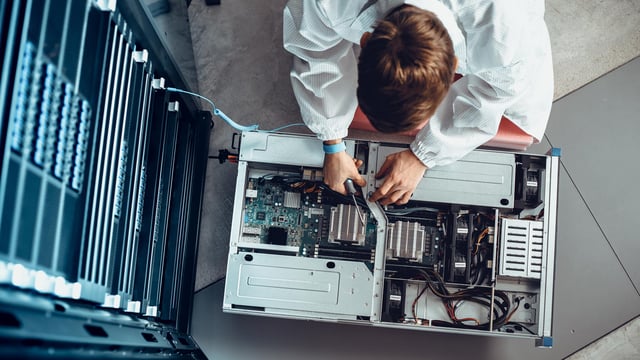What is Hardware Asset Management?

What is Hardware Asset Management?
Hardware Asset Management is a fundamental procedure for every IT department. However, tracking and maintaining hardware equipment can be laborious and challenging at times. Many companies struggle to simply keep track of their current hardware inventory, not to mention maintain hardware asset assignment and maintenance records.
Hardware is a physical device or internal component that is essentially used in every area of business. Unlike digital software applications that can be digitally tracked and monitored with an automated Software Asset Management solution, hardware requires more manual steps to keep an accurate inventory.
Fortunately, there are ways to automate and streamline Hardware Asset Management procedures with an HAM solution that automates these processes and enhances overall hardware inventory and asset insights.
Hardware Asset Management Defined
Hardware Asset Management (HAM) is the process of tracking, monitoring, and maintaining hardware devices and equipment throughout their period of use, known as the asset lifecycle. Hardware refers to tangible technological assets, including devices and computer components used to process, transfer, and store information. Hardware is used in nearly every area of business, but HAM procedures are executed by the IT department. There are many tasks involved in IT Hardware Asset Management, with some of the most prominent being record keeping, inventorying, maintenance, upgrading, and asset usage optimization.
Hardware Asset Management is a subset of IT Asset Management (ITAM). IT Asset Management consists of Hardware Asset Management (HAM) and Software Asset Management (SAM). Whereas SAM deals with the tracking and monitoring of intangible or digital assets, such as applications, programs, or databases, HAM covers the tracking and maintenance of intangible or physical tech-related equipment. Equipment asset management workflows align with each stage of the Hardware Asset Management lifecycle.
The Hardware Asset Management lifecycle is broken down into five stages: Planning, Procurement, Deployment, Service, Retirement. For each stage of the lifecycle, there are relevant hardware asset tracking procedures. Although Hardware Asset Management is a fundamental IT process, many companies struggle to maintain an accurate hardware inventory and optimize their resources.
Hardware asset tracking involves several procedures that must be performed manually, however, with a software solution, such as USU’s HAM solution, many of these steps or procedures can be automated or at the very least streamlined. Having a strong HAM strategy will not only improve process efficiency and the accuracy of the hardware inventory, but also enhance visibility into hardware asset usage. Having a clear image of the hardware inventory and maintenance records enables IT management to strategize and optimize current asset usage when needed and ultimately prevent unnecessary spending.
What is Hardware?
Hardware is technological devices or equipment used to process, transfer, and store information. There are two types of hardware equipment: internal hardware and external hardware. Internal hardware refers to the inner components of a technology device, including hard drives, motherboards, RAM, and CPUs. External hardware, on the other hand, refers to devices such as keyboards, USB drives, external hard drives, printers, scanners, monitors, webcams, etc.
Hardware is used in both private and corporate environments. In the business world, the IT department is responsible for the acquisition, tracking, and maintenance of all hardware assets. Procuring IT hardware is essential for all areas of business. Likewise, the asset tracking of hardware is essential for managing inventory, ownership, and maintenance or repair records.
The 5 Stages of the Hardware Asset Management Lifecycle
1. Planning
The first stage of the Hardware Asset Management lifecycle is the planning stage; this stage is where current resources are assessed and the use of new resources is forecasted.
2. Procurement
The second stage of the Hardware Asset Management lifecycle is the procurement stage in which an asset will be purchased, delivered to the appropriate office or facility and installed if necessary.
3. Deployment
The deployment stage of the Hardware Asset Management lifecycle is the spool up phase. This stage involves testing or troubleshooting the new asset and recording all relevant information into a hardware inventory database.
4. Service
Once the asset has been successfully added to the hardware inventory and tested for functionality, it can be put to use.
5. Retirement
The final stage of the Hardware Asset Management lifecycle is the retirement stage. This phase marks the end of the asset’s usability or usefulness. There can be many different reasons to retire a hardware asset.
Challenges of Hardware Asset Management
Hardware Asset Management is intended to organize and improve the tracking and maintenance of a company’s hardware inventory, however, sometimes the challenges associated with hardware inventory tracking can be quite difficult to resolve. Here are some of the most common challenges companies face throughout the Hardware Asset Management process:
Staying Organized
Lack of Tracking Automation
Incomplete Inventory and Maintenance Records
HAM Service and Support:
Most hardware assets will require maintenance or troubleshooting support at one point or on several occasions throughout their lifecycle. However, if an asset has an incomplete maintenance record or other missing information, this may force IT support to invest extra time in the research of information about the asset in order to find a solution. Naturally, this will lead to extended downtimes and decreased productivity. However, an efficient Hardware Asset Management solution can easily resolve this issue with immediate access to maintenance records, asset configurations, and other useful information.
An incomplete or disorganized hardware asset inventory can result in both financial loss and security risks. Unregistered hardware assets can’t be tracked, thereby increasing the risk of theft. Furthermore, some of these assets, such as laptops and mobile devices, can contain sensitive information that could consequently be at risk of a security breach if stolen. In any case, integrating a strong HAM solution into your IT environment is critical and worthwhile.
USU Hardware Asset Management
USU’s premium Hardware Asset Management software is designed to simplify and streamline your HAM tracking and monitoring workflows. Organize your entire hardware asset estate into one centralized platform complete with detailed insights, improved security, and enhanced visibility. USU’s HAM dashboard displays all the asset information you need for easy access and seamless tracking. The automated Discovery and Monitoring feature also enables you to quickly scan your entire network and check for connected devices to maintain inventory accuracy.
Hardware assets can be difficult to keep record of and track relevant information, such as device ownership and repairs. To maintain an accurate inventory, improve security, and keep asset records up-to-date throughout their lifecycle, the most efficient and cost-effective way is to integrate a HAM solution that will automate and streamline for maximum efficiency. Our Hardware Asset Management solution was thoughtfully developed with the challenges of HAM in mind, with features and functions that drive productivity and directly address those challenges.
Frequently Asked Questions
What are hardware assets?
What is the difference between hardware and software asset tracking?
How do you track hardware inventory?
There are several ways to track your hardware asset inventory. First and foremost, it’s important to have a thorough record of all internal and external hardware, including their purchase dates, warranties, manuals, serial numbers, ownership, etc. To more easily track the information associated with each asset, hardware should be tagged with a QR or barcode. All maintenance, including upgrades and repairs, must also be tracked throughout an asset’s lifecycle.
With a Hardware Asset Management software like USU’s HAM solution, tracking and monitoring IT hardware inventory can be streamlined and drive productivity.
Get in touch with an expert
Have questions about our offering? A quick call can be way more helpful than a long email chain. Talk to one of our experts to explore our products and see them in action.

Brian Riley
Sales Development
IT Asset Management
Send us a message
No matter if you like to partner with USU or just have a few questions.

